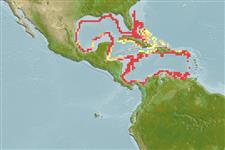Environment: milieu / climate zone / depth range / distribution range
Ecologia
marino batidemersale; distribuzione batimetrica 400 - 500 m (Ref. 1371), usually 400 - 500 m (Ref. 1371). Deep-water; 31°N - 7°N, 98°W - 63°W (Ref. 1371)
Western Atlantic: Florida, USA and northern Gulf of Mexico through Central America to Venezuela.
Size / Peso / Age
Maturity: Lm ? range ? - ? cm
Max length : 40.5 cm TL maschio/sesso non determinato; (Ref. 49695)
Spine dorsali (totale): 1; Spine anali 0; Raggi anali molli: 123 - 125. Body long, compressed, tapering to a fine point posteriorly; anus situated between pelvic fins widely separated from the urogenital opening situated anterior to anal fin origin. A striated light organ is present on the ventral half of the body and on the sides of the head. Pyloric caeca absent. First pelvic fin ray long, filamentous, reaching to anus when depressed. Color is silvery, the dorsal portions slightly brownish, purplish ventrally; oral cavity darker.
Inhabits the outer shelf and upper slopes, on soft bottoms.
Life cycle and mating behavior
Maturità | Riproduzione | Deposizione | Uova | Fecundity | Larve
Cohen, D.M., T. Inada, T. Iwamoto and N. Scialabba, 1990. FAO species catalogue. Vol. 10. Gadiform fishes of the world (Order Gadiformes). An annotated and illustrated catalogue of cods, hakes, grenadiers and other gadiform fishes known to date. FAO Fish. Synop. 125(10). Rome: FAO. 442 p. (Ref. 1371)
IUCN Red List Status (Ref. 130435)
Threat to humans
Harmless
Human uses
Pesca: di nessun interesse
Informazioni ulteriori
BibliografiaAcquacolturaProfilo di acquacolturaVarietàGeneticaElectrophoresesEreditarietàMalattieElaborazioneNutrientsMass conversion
Strumenti
Special reports
Download XML
Fonti Internet
Estimates based on models
Preferred temperature (Ref.
123201): 8.4 - 16.5, mean 10.6 °C (based on 27 cells).
Phylogenetic diversity index (Ref.
82804): PD
50 = 1.0000 [Uniqueness, from 0.5 = low to 2.0 = high].
Bayesian length-weight: a=0.00339 (0.00129 - 0.00890), b=3.11 (2.89 - 3.33), in cm total length, based on LWR estimates for this (Sub)family-body shape (Ref.
93245).
Trophic level (Ref.
69278): 3.6 ±0.3 se; based on size and trophs of closest relatives
Fishing Vulnerability (Ref.
59153): Low to moderate vulnerability (31 of 100).
Nutrients (Ref.
124155): Calcium = 38.7 [19.0, 99.5] mg/100g; Iron = 0.528 [0.209, 1.238] mg/100g; Protein = 16.9 [15.1, 18.6] %; Omega3 = 0.239 [0.104, 0.522] g/100g; Selenium = 16.8 [6.5, 40.8] μg/100g; VitaminA = 18.6 [3.6, 84.5] μg/100g; Zinc = 0.366 [0.228, 0.582] mg/100g (wet weight);
